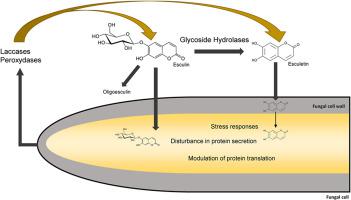Responses to and detoxification of esculin in white-rot fungi
IF 2.9
3区 生物学
Q2 MYCOLOGY
引用次数: 0
Abstract
Plant metabolites have a great potential for limiting the spread of harmful fungi. However, a better understanding of the mode-of-action of these molecules and the defense systems developed by fungi to resist them, is needed to assess the benefits/risks of using them as antifungal treatment. White-rot fungi are excellent models in this respect, as they have adapted to the hostile habitat that is wood. In fact, wood is a source of putative antifungal compounds that can be derived using extraction techniques. In this study, we demonstrated that esculin and esculetin, which are coumarins found in plants and wood, reduce the growth of the wood-rotting fungi Fomitiporia mediterranea, Phanerochaete chrysosporium, Pycnoporus cinnabarinus and Trametes versicolor. We have shown that extracellular strategies are developed by the fungi to deal with esculin, through the involvement of laccases, peroxidases and glycoside hydrolases, and intracellular strategies, mainly via upregulated protein translation. Comparative proteomic and metabolomic approaches revealed that, despite the fact that the species analysed are closely related (they all belong to the Agaricomycetes, and have the same trophic mode), their defense responses to esculin differ.


白腐真菌对esculin的反应和解毒作用
植物代谢物在限制有害真菌的传播方面潜力巨大。不过,需要更好地了解这些分子的作用模式以及真菌为抵御这些分子而开发的防御系统,以评估将这些分子用作抗真菌治疗的益处/风险。在这方面,白腐真菌是极好的典范,因为它们已经适应了木材这一恶劣的栖息地。事实上,木材是一种可利用萃取技术提取的假定抗真菌化合物的来源。在这项研究中,我们证明了在植物和木材中发现的香豆素--esculin 和 esculetin--可以减少木腐真菌 Fomitiporia mediterranea、Phanerochaete chrysosporium、Pycnoporus cinnabarinus 和 Trametes versicolor 的生长。我们的研究表明,这些真菌开发了细胞外策略和细胞内策略,细胞外策略是通过裂解酶、过氧化物酶和糖苷水解酶的参与来处理酯素,细胞内策略主要是通过上调蛋白质翻译来处理酯素。比较蛋白质组和代谢组的方法显示,尽管所分析的菌种关系密切(它们都属于姬松茸目,具有相同的营养模式),但它们对esculin的防御反应却各不相同。
本文章由计算机程序翻译,如有差异,请以英文原文为准。
求助全文
约1分钟内获得全文
求助全文
来源期刊

Fungal biology
MYCOLOGY-
CiteScore
5.80
自引率
4.00%
发文量
80
审稿时长
49 days
期刊介绍:
Fungal Biology publishes original contributions in all fields of basic and applied research involving fungi and fungus-like organisms (including oomycetes and slime moulds). Areas of investigation include biodeterioration, biotechnology, cell and developmental biology, ecology, evolution, genetics, geomycology, medical mycology, mutualistic interactions (including lichens and mycorrhizas), physiology, plant pathology, secondary metabolites, and taxonomy and systematics. Submissions on experimental methods are also welcomed. Priority is given to contributions likely to be of interest to a wide international audience.
 求助内容:
求助内容: 应助结果提醒方式:
应助结果提醒方式:


